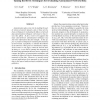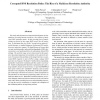NDSS
2008
IEEE
14 years 6 months ago
2008
IEEE
NDSS
2008
IEEE
14 years 6 months ago
2008
IEEE
NDSS
2008
IEEE
14 years 6 months ago
2008
IEEE
The Tor anonymous communication network uses selfreported bandwidth values to select routers for building tunnels. Since tunnels are allocated in proportion to this bandwidth, thi...
NDSS
2008
IEEE
14 years 6 months ago
2008
IEEE
Installing various hooks into the victim system is an important attacking strategy employed by malware, including spyware, rootkits, stealth backdoors, and others. In order to def...
NDSS
2008
IEEE
14 years 6 months ago
2008
IEEE
Anonymization plays a key role in enabling the public release of network datasets, and yet there are few, if any, techniques for evaluating the efficacy of network data anonymiza...
NDSS
2008
IEEE
14 years 6 months ago
2008
IEEE
NDSS
2008
IEEE
14 years 6 months ago
2008
IEEE
We study and document an important development in how attackers are using Internet resources: the creation of malicious DNS resolution paths. In this growing form of attack, victi...
NDSS
2008
IEEE
14 years 6 months ago
2008
IEEE
Protocol reverse engineering is the process of extracting application-level specifications for network protocols. Such specifications are very helpful in a number of security-re...
NDSS
2008
IEEE
14 years 6 months ago
2008
IEEE
In [22] we showed that existing single-server computational private information retrieval (PIR) protocols for the purpose of preserving client access patterns leakage are orders o...
NDSS
2008
IEEE
14 years 6 months ago
2008
IEEE
Third Generation (3G) cellular networks utilize timevarying and location-dependent channel conditions to provide broadband services. They employ opportunistic scheduling to effic...




